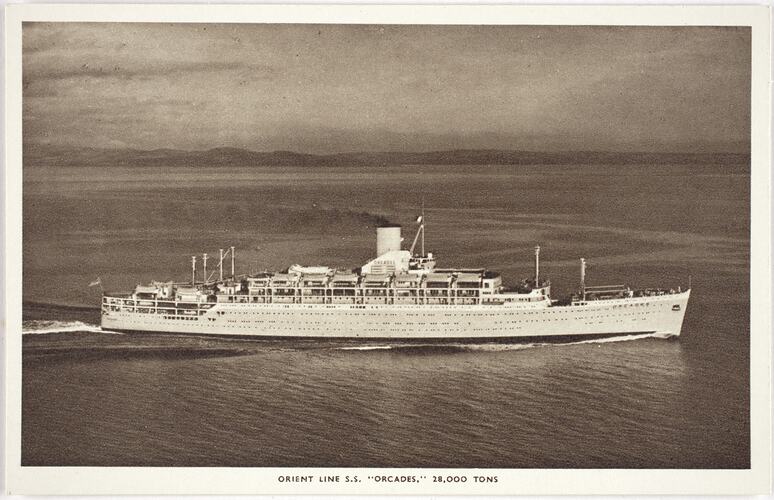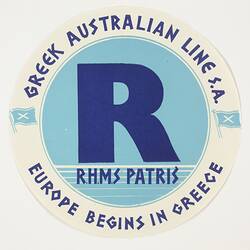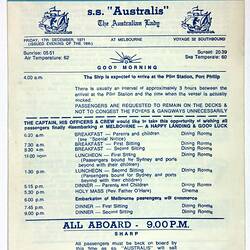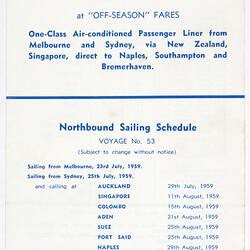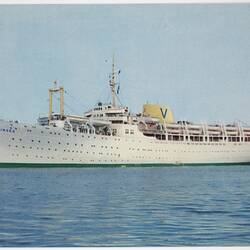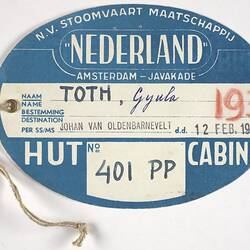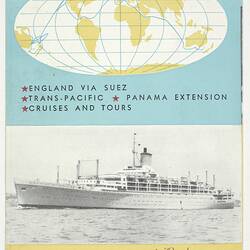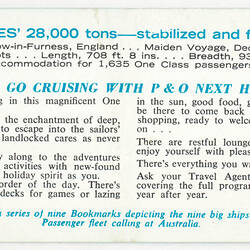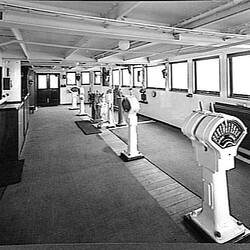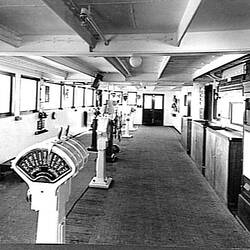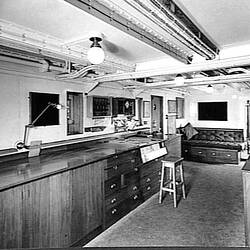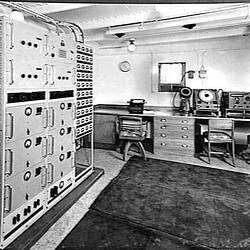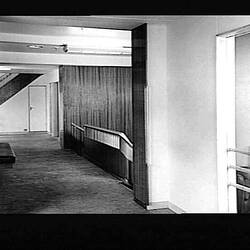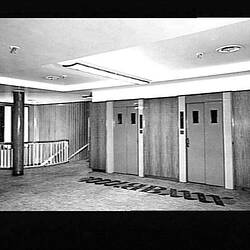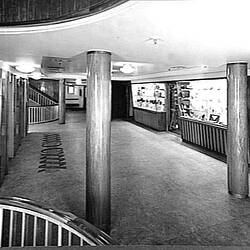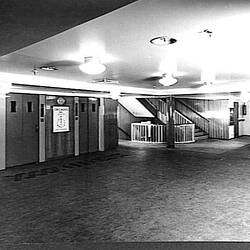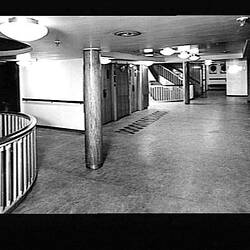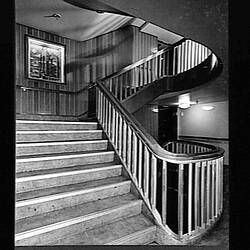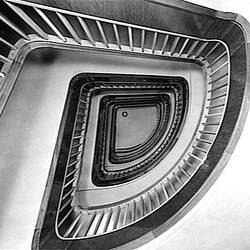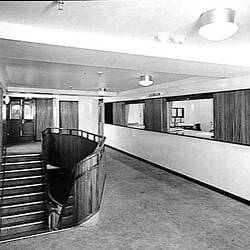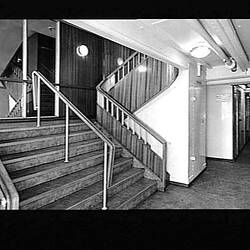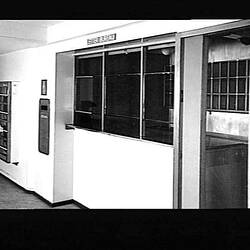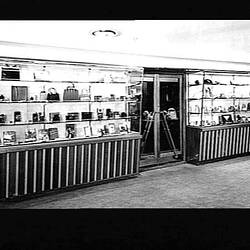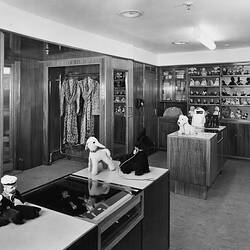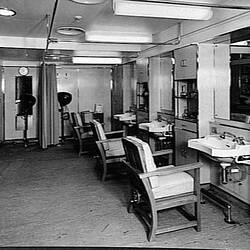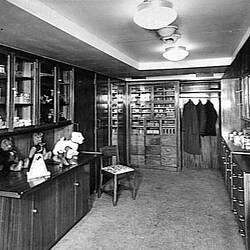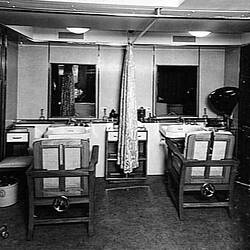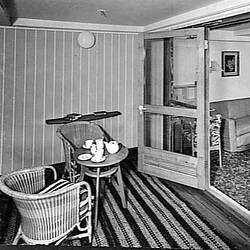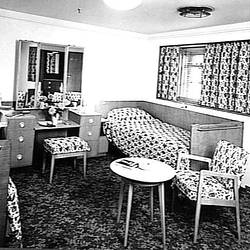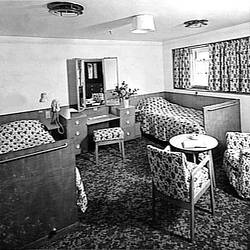Summary
History of the post World War II Migrant Ship Orcades. When commissioned she was the largest and fastest passenger ship on the Australian trade. Many immigrants travelling on the Orcades recall the luxuries they experienced on the journey.
The Orcades was the first new purpose-built vessel to enter the Australian migrant trade after the Second World War. She set a new standard in style and accommodation, offering multiple saloons, shops, a hair salon, hospital, swimming pool, and a range of cabin choices.
Many immigrants to Australia travelled on the Orcades and remember her sense of style and the feeling of 'old world' luxury they experienced.
Facts at a Glance
Dimensions: 709 x 94 ft (216 x 28.7 m)
Registered Tonnage: 28,164 tons gross
Service Speed: 22 knots
Propulsion: Reduction geared steam turbines/twin screws
Shipping Line: Orient Line
History of the Ship
The Orcades was the third ship of this name to serve the Orient Line. Built at a cost of 3,500,000 (English) pounds, she was the first replacement for four large passenger ships that the Orient Line had lost during World War Two.
When commissioned, she was the largest and fastest passenger ship on the Australian trade, achieving up to 24.74 knots in her acceptance trials, although 22 knots was always stated as her service speed.
After being launched on 14 October 1947, the Orcades was fitted out with accommodation for a total of 1,545 passengers over two classes - 773 in first class and 772 in tourist class. Having been built for the Orient Line's regular scheduled Australian passenger service, the Orcades carried government and business passengers, as well as maintaining a mail contract. Of course, as a British ship, she also carried immigrants from her maiden voyage.
Immigrant Ship to Australia
The Orcades left Tilbury Docks, London, for her maiden voyage to Australia on 14 December 1948, arriving in Fremantle on 6 January and Melbourne on 10 January. During this voyage, she set a new speed record for the London to Melbourne route, taking ten days off the pre-war record. She made well over 55 voyages to Australia between 1948 and 1972, travelling via the Suez Canal until 1955 when she made her first voyage via Panama. In November 1956 the Orcades arrived in Melbourne as part of a world tour just prior to the opening of the Olympic Games, bringing hundreds of visitors from America for the Games, which ran from Thursday 22nd November to Saturday 8th December.
Later that year, she was refitted by Harland & Wolff. Air-conditioning was installed throughout the entire ship and a new swimming pool was added to first class, with the old pool being allocated to tourist class. She was again refitted in 1964 - this time to accommodate 1,635 passengers in a single class, but after this time was used for cruising more often than immigration travel.
Passenger Experiences of the Journey
Many immigrants travelling on the Orcades recall her grandeur and the luxuries they experienced on the journey - a far cry from the war-ravaged countries they left behind.
In an anonymous journal, recording a journey on the Orcades from September to October in 1949, the author's tone is positive and light hearted but their glowing descriptions of shipboard fare are coloured by the memory of post-war England, rationing and straightened circumstances:
'For lunch we had soup, oxtail and vegetables, rice pudding rolls and cheese (a helping which is greater than a person's ration for a week). What there is for dinner this evening I can't remember, anyway I have rumbles in my tummy just to anticipate it. I'm doing justice to my "inards", the first time in years.'.
September 1949.
Glenn Shorrock, former lead singer of the Little River Band, migrated from England on the Orcades in 1954:
'We came from working class London, and to have waiters and dining rooms . it was all a bit posh, but a great adventure!'.
Her Final Voyage
When her immigration travels came to an end, the Orcades left Sydney for the last time on 3 June 1972, bound for Britain. For a while, she made a short number of cruises out of Southampton, but departed on 28 December 1972 for the shipbreakers in Kaohsiung, Taiwan.
References:
Baty, S. 1984. Ships That Passed - The Glorious Era of Travel to Australia and New Zealand. Reed Books Pty Ltd. Frenchs Forest.
Plowman, P. 1992. Emigrant Ships to Luxury Liners. New South Wales University Press.
Kensington. Stodden, K. 2003 (October). Appendix A - Tally of Voyages. Prepared for the Ship Reunion Lecture. Immigration Museum, Melbourne.
More Information
-
Keywords
-
Authors
-
Article types
